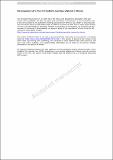Development of a two-hit lethal liver injury model in swine
Author(s)
Lagazzi, Emanuele; Wei, Helen S.; Panossian, Vahe S.; Pallotta, Jessica B.; Calisir, Anet; Rafaqat, Wardah; Abiad, May; Nzenwa, Ikemsinachi C.; King, David R.; Hong, Celestine; Hammond, Paula; Olsen, Bradley; Duggan, Michael J.; Velmahos, George C.; ... Show more Show less
Download68_2024_2546_ReferencePDF.pdf (3.306Mb)
Open Access Policy
Open Access Policy
Creative Commons Attribution-Noncommercial-Share Alike
Terms of use
Metadata
Show full item recordAbstract
Purpose Noncompressible truncal hemorrhage remains a leading cause of preventable death in the prehospital setting. Standardized and reproducible large animal models are essential to test new therapeutic strategies. However, existing injury models vary significantly in consistency and clinical accuracy. This study aims to develop a lethal porcine model to test hemostatic agents targeting noncompressible abdominal hemorrhages. Methods We developed a two-hit injury model in Yorkshire swine, consisting of a grade IV liver injury combined with hemodilution. The hemodilution was induced by controlled exsanguination of 30% of the total blood volume and a 3:1 resuscitation with crystalloids. Subsequently, a grade IV liver injury was performed by sharp transection of both median lobes of the liver, resulting in major bleeding and severe hypotension. The abdominal incision was closed within 60 s from the injury. The endpoints included mortality, survival time, serum lab values, and blood loss within the abdomen. Results This model was lethal in all animals (5/5), with a mean survival time of 24.4 ± 3.8 min. The standardized liver resection was uniform at 14.4 ± 2.1% of the total liver weight. Following the injury, the MAP dropped by 27 ± 8mmHg within the first 10 min. The use of a mixed injury model (i.e., open injury, closed hemorrhage) was instrumental in creating a standardized injury while allowing for a clinically significant hemorrhage. Conclusion This novel highly lethal, consistent, and clinically relevant translational model can be used to test and develop life-saving interventions for massive noncompressible abdominal hemorrhage.
Date issued
2024-05-23Department
Massachusetts Institute of Technology. Department of Chemical EngineeringJournal
European Journal of Trauma and Emergency Surgery
Publisher
Springer Berlin Heidelberg
Citation
Lagazzi, E., Wei, H.S., Panossian, V.S. et al. Development of a two-hit lethal liver injury model in swine. Eur J Trauma Emerg Surg 50, 1891–1901 (2024).
Version: Author's final manuscript